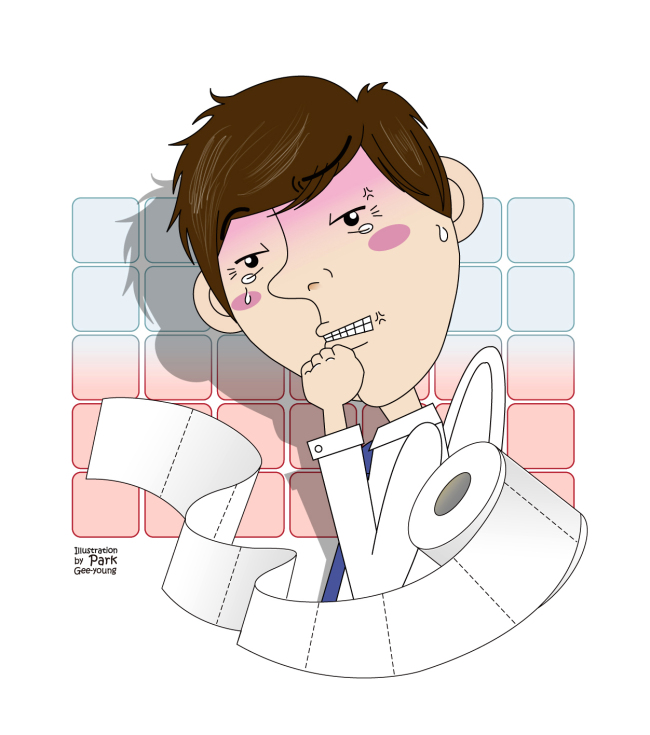The Korean term for hemorrhoids originally referred to various diseases that occur in the anal area, including hemorrhoids, tears and fistulas, but the term usually refers to hemorrhoids.
Hemorrhoids were believed to be caused by dilation of submucosal venous plexus in the anus, but more recent studies have shown that they are not simply caused by the dilated venous plexus, but due to protrusion of the so called “anal cushion” consisting of blood vessels, muscles and connective tissue.
Hemorrhoids were believed to be caused by dilation of submucosal venous plexus in the anus, but more recent studies have shown that they are not simply caused by the dilated venous plexus, but due to protrusion of the so called “anal cushion” consisting of blood vessels, muscles and connective tissue.

Symptoms of hemorrhoids
The most common symptom is bleeding. The blood is bright red and the bleeding occurs during or after opening the bowels. This is worsened when straining to defecate, or with increased frequency of bowel opening. Continued bleeding can lead to anemia. However, if the blood is not bright red, but black in color, it may be caused by other conditions, such as bowel tumors.
Another common symptom is protrusion of the hemorrhoid, which can protrude during defecation, and spontaneously reduce (return) to its position afterwards. In more severe cases, the hemorrhoid needs to be pushed in manually, or even worse, it may not be possible to reduce it.
Pain is associated with thrombosis or ulcers, and is often not associated with hemorrhoids. Constipation is not a symptom of hemorrhoids, but the two condition can worsen each other.
Classification of hemorrhoids
Hemorrhoids can be classified according to their position relative to the dentate line. Internal hemorrhoids are above the dentate line, which is about one-third of the way into the anus. External hemorrhoids are below the dentate line.
If there is severe pain, it is likely to be due to external hemorrhoids.
Internal hemorrhoids can be further classified into type 1, where there is only bleeding, type 2, where there is a the hemorrhoid pushes out while defecating but it spontaneously recedes, type 3, where the hemorrhoids have to be pushed back in, and type 4, where reduction is not possible.
Hemorrhoids in women
The exact frequency of hemorrhoids in Korea is not known, but they are said to be present in about 5 percent of the Western population. There is a trend of increasing prevalence of hemorrhoids in Korea.
Hemorrhoids are often thought to be more common in women, but in fact, it is approximately 1.3 to 2 times more common in men. For women, the prevalence increases with pregnancy and childbirth, with symptoms becoming more severe. More recently, the increase in the number of women drinking alcohol has been associated with worsening symptoms.
There are a significant number of women suffering from hemorrhoids during pregnancy. This is because during pregnancy, the hormonal changes and the changes in the size of the uterus cause abnormal blood flow, while also increasing abdominal pressure, which contributes to increased blood flow to the anal vessels, enlarging the hemorrhoids.
Treatment options for hemorrhoids in pregnancy include conservative options such as using a sitz bath and fecal softeners. However, if there is severe pain brought on by serious conditions, surgery is often carried out.
Some patients worry about the potential adverse effects of anesthesia and surgery to the fetus, but because only pharmacological agents that do not affect the fetus are used, this is not something to be worried about.
Hemorrhoids that occur during pregnancy can improve with the use of sitz bath after giving birth, but with continued hemorrhoids, surgery is the best option.
Prevention of hemorrhoids
Many people have a habit of reading the newspaper or magazines while on the toilet. However, this leads to increased time defecating, which can worsen hemorrhoids. Other effective preventive methods include changing ones diet to prevent constipation or diarrhea, and minimizing the time spent on the toilet.
Regular warm water sitz baths can improve the blood circulation in the anus to prevent worsening of hemorrhoids. Binge drinking can cause blood to pool in the hemorrhoid vessels while also inducing diarrhea, so alcohol should be avoided.
Treatment of hemorrhoids
For type 1 and 2 hemorrhoids, conservative treatment is indicated. These include warm baths, drinking enough water and eating plenty of fiber. For types 3 and 4, it is difficult to treat hemorrhoids with conservative methods alone.
For less severe cases, non-surgical methods such as rubber band ligation, injection therapy, cryosurgery, and infrared coagulation can be used. The fundamental treatment for hemorrhoids is surgical removal of the anal hemorrhoid tissue with anesthesia.
More recently, hemorrhoidectomy using automatic staplers has been performed, which reduces pain after the procedure compared to the previous surgical methods.
By Lee Yoo-yong
The author is a doctor at Department of Surgery at Samsung Medical Center and a professor of Sungkyunkwan University School of Medicine. ― Ed.
-
Articles by Korea Herald









![[Music in drama] Rekindle a love that slipped through your fingers](http://res.heraldm.com/phpwas/restmb_idxmake.php?idx=644&simg=/content/image/2024/05/01/20240501050484_0.jpg&u=20240501151646)

![[New faces of Assembly] Architect behind ‘audacious initiative’ believes in denuclearized North Korea](http://res.heraldm.com/phpwas/restmb_idxmake.php?idx=644&simg=/content/image/2024/05/01/20240501050627_0.jpg&u=20240502093000)







